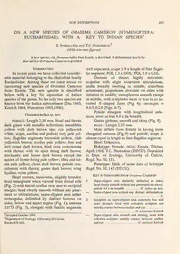
On an new species of Orasema Cameron (Hymenoptera: Eucharitidae), with a key to Indian species PDF
Preview On an new species of Orasema Cameron (Hymenoptera: Eucharitidae), with a key to Indian species
NEW DESCRIPTIONS 355 ON A NEW SPECIES OF ORASEMA CAMERON (HYMENOPTERA: EUCHARITIDAE), WITH A KEY TO INDIAN SPECIES1 S. SnehalathaandT.C.Narendran2 (Withninetext-figures) A newspecies,viz.OrasemaindicafromKerala, is described. Adichotomouskeyto In- dianspeciesofOrasemaCameronisprovided. Introduction well separated, scape 1.9 x length of first flagel- In recent years we have collected consider- larsegment; POL 1.3 x OOL; POL 1.9 x LOL. able material belonging to the chalcidoid family Dorsum of thorax highly reticulate; Eucharitidae. Among these we came across an scapulae with slight transverse reticulations, interesting new species of Orasema Cameron axilla broadly meeting in middle, scutellum from Kerala. The new species is described acuminate; propodeum alveolate on sides with below with a key for separation of Indian striation in middle; mesopleuron smooth except species ofthe genus. So faronly two species are in middle, with sculptures more or less in an in- known from the Indian subcontinent (Das 1963, verted Y-shaped form (Fig 4); sm:m:pm = Kerrich 1964, Narendran 1985,1986). 8.6:5.8:2.8 (Figs. 6-7). Petiole elongate with longitudinal stria- Orasema indicasp. nov. tions, more orless 4.8 x its breadth. FEMALE: Length 2.38 mm. Head and thorax Gasterglobose, smooth and shiny (Fig, 8). dark green with metallic reflections; mandibles MALE Length 2.35 mm. : yellow with dark brown tips; eye yellowish Male differs from female in having more white; scape, anellus and pedicel very pale yel- elongated antenna (Fig.9) and petiole; scape is low, flagellar segments brownish yellow, club almost equal in length to first flagellarsegment. yellowish brown; ocellus pale yellow; fore and Host: Unknown. mid coxae dark brown, hind coxa concolorous Holotype: Female. India: Kerala, Trichur, with thorax with its apex being dark brown; April 1986, T.C. Narendran (DZCU). Deposited trochanter and femur dark brown except the in Dept, of Zoology, University of Calicut, apices of femur being pale yellow; tibia and tar- Regd. No. SL 151. sus pale yellow; claws dark brown; petiole con- Paratype: Male of same data of holotype colorous with thorax; gaster dark brown; wing Regd. No. SL 145 (DZCU). hyaline, veins yellow. KeytoIndianspeciesofOrasemaCameron Head convex, transverse, slightly broader; head emarginate when viewed from dorsal side 1. Supra-clypeal area distinctly delimited at sides; (Fig. 2) withlateral ocellus very nearto occipital headclearlysmoothwithoutanypuncturationsabove; margin; head clearly smooth without any punc- — petiole4.8xitsbreadth O. indicasp. nov. Supra-clypeal areawithoutany distinct delimitations tures or reticulations; supra-clypeal area rather 2 rectangular, delimited by distinct furrows on 2. Sculpture on supra-clypeal area extremely fine and sides, below and upper region (Fig. 1); antenna quite distinct; head with reticulate sculpture not 11173 (Fig. 5), elongate with funicle segments notablycoarserbetweenocellusandeye — O. assectatorKerrich AcceptedOctober 1991 Supra-clypeal area smooth and shining; head with departmentofZoology,UniversityofCalicut, reticulatesculpture notably coarser between ocellus Kerala673635, andeye O. initiatorKerrich 356 JOURNAL BOMBAY NATURAL HIST. SOCJEJY, Vol. 89 Figs. 1-9. Orasema indicasp. nov. 1. Head, frontal view; 2. Head,dorsal view;3. Head, lateralview;4. Mesopleuron;5. Antenna;6. Forewing; 7. Forewingvenationenlarged;8.Gaster; 9. Maleantenna. NEW DESCRIPTIONS 357 Acknowledgements University of Calicut for financial assistance for One of the authors (S.S.) is grateful to the undertakingstudies on Indian Eucharitidae. ReferENCES Das, G.M. (1963): Preliminary studies on the biology of Narendran, T.C. (1985): A Review of the Family Orasema assectator Kerrich (Hymenoptera: Eucharitidae. The Chalcidoidea (Insecta: Hymenop- Eucharitidae) parasitic on Pheidole and causing tera) ofIndia and the adjacentcountries. OrientalIn- damage to leaves oftea in Assam.Bull. ent. Res. 54: sects19 :186-187. 373-378. Narendran, T.C. (1986): A Catalogue of the Family Kerrich, G.J. (1964): Descriptions of two species of Eucharitidae. The Chalcidoidea (Insecta: Hymenop- Eucharitidae damaging tea. Bull. ent. Res. 54: 365- tera) ofIndia and the adjacentcountries. OrientalIn- 371. sects20:51-55. A NEW FISH OF THE GENUS PUNTIUS HAMILTON (OSTARIOPHYSI CYPRINIDAE) FROM GOA1 : B.F. Chhapgar2 and S.R. Sane3 (With two plates) Among the live fish exported from India lateral line and (5) two vertical dark bands for the pet trade is one popularly called indigo on the body (during life). barb (Barbus narayani). It is conjectured that Description this fish may have been identified as such due to its colour resemblance to Puntius narayani D. 3/8, P.1/12-14, V. 1/8, A. 2/5, C. 19. , recorded by Hora in 1937 from the Cauvery L.l. 20 (17-22); 1. tr. 5/3-4. river in Coorg. On closer inspection, it was Head and body compressed, belly found that the indigo barb is actually a new rounded. Dorsal and ventral profiles greatly species. We are naming itPuntius setnai. [Raj arched,the formermoresothanthelatter.Head Tilak (1969) did not come across this species short, conical. Eyes lateral. No tubercles on in Goa.] cheek and snout. Barbels absent. Dorsal fin insertedslightly nearertip ofsnoutthancaudal Puntius setnai sp. nov. base. Lastunbranchedray ofdorsal finosseous Specimens studied: Holotype; total and serrated. Caudal fin forked, lobes more length 47 mm, standard length 35.5 mm, from or less equal, slightly pointed, about twice Sanguem, Goa. Paratypes; 24 exs. 40 to 57 longerthanmedianrays. Laterallinecomplete, mm total length, from clear streams in San- typically perforating 20scales. It runs horizon- guem and Ponda, Goa. The holotype and some tally up to the posterior border of the first of the paratypes will be deposited with the dark band, then dips down and, at the seventh Zoological Survey of India, Calcutta. scale, again runs horizontally in a gentle arc Diagnosis: This species can be distin- to the tail. PDS 7, circumpeduncular V2 5 V2 . guished by (1) absence of barbels, (2) last un- Morphometry: (ofholotype, all measure- divided ray of dorsal fin osseous and serrated, ments inmillimetres) Total length47, standard (3) complete lateral line, (4) 20 scales along length 35.5, body depth 15.33, head length 1AcceptedOctober1992. 9.67, head depth 8.33, predorsal length 19.95, ^araporevalaAquarium,NetajiSubhashRd.,Bombay400002. post-dorsal length 20.84, pre-pelvic length 3Sachetan,L4/5,SitaramBuilding,PaltonRd.,Bombay 400001 20.40, preanal length 28.0, length of caudal
